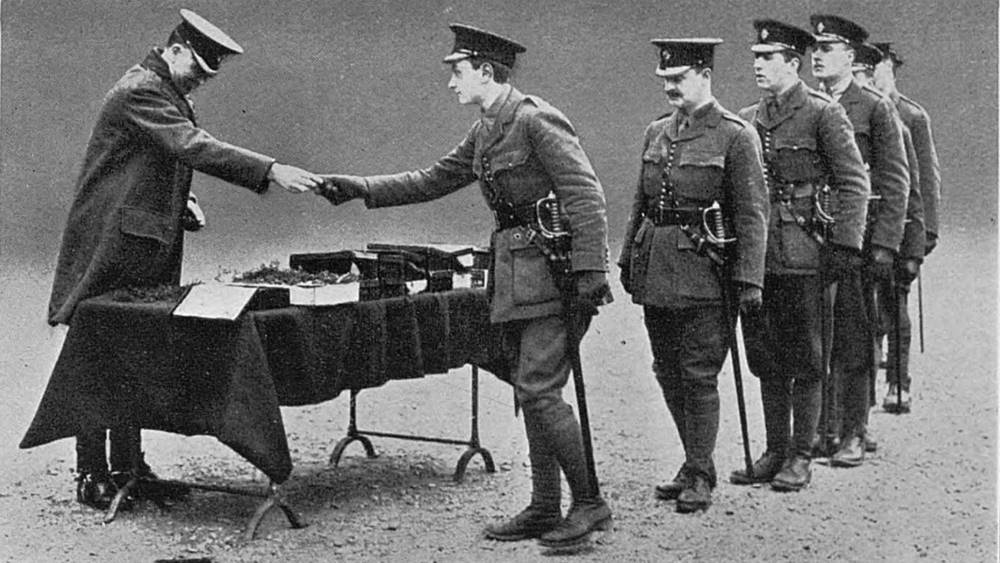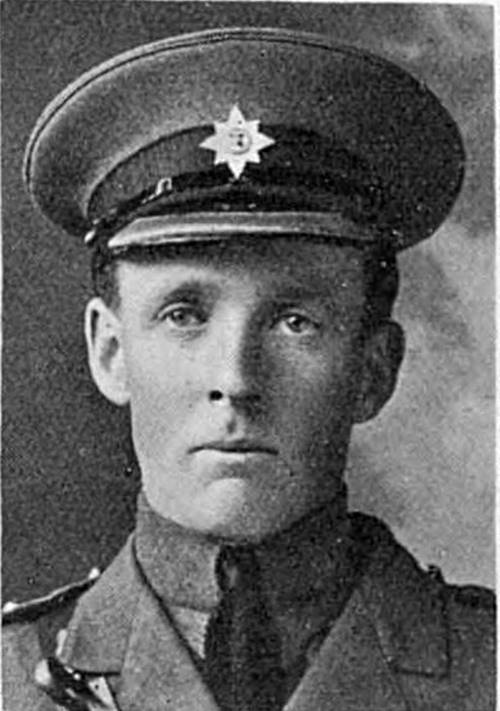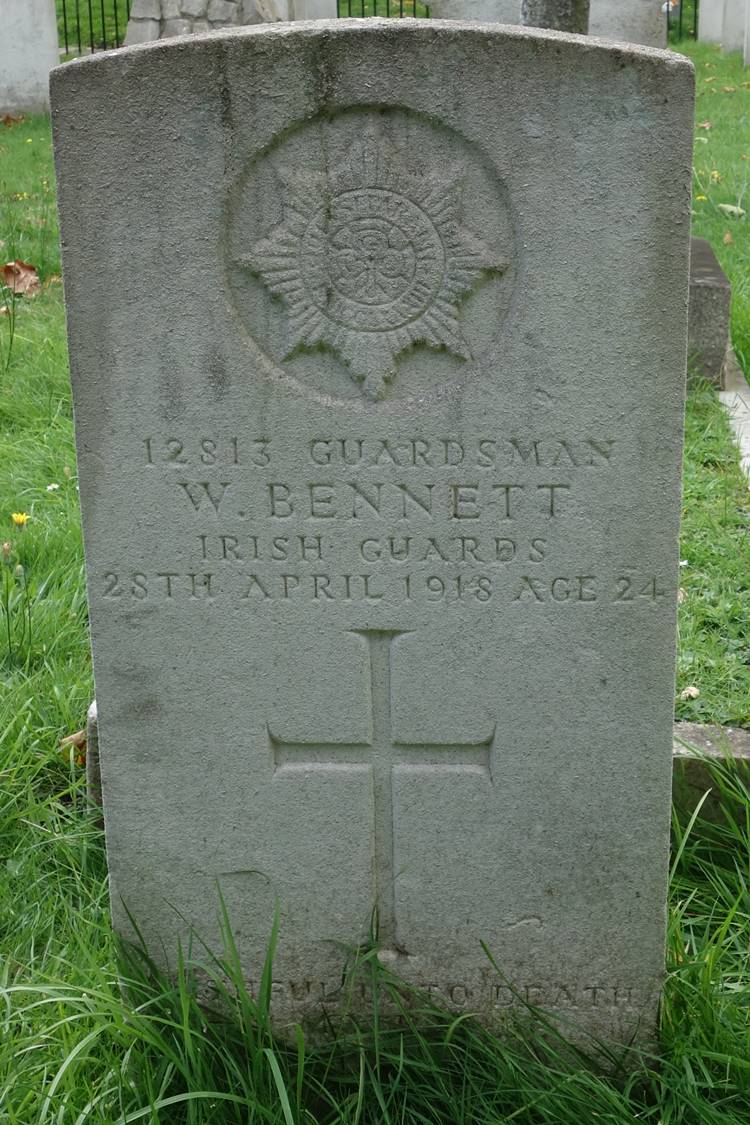This article looks at the service of the Irish Guards during the First World War and will help you to research soldiers who served with the Regiment. This is one of a series of guides I have created to help you research soldiers who served in the British Army:
The Irish Guards in the First World War

Two battalions of the Irish Guards served abroad during the First World War on the Western Front where they both suffered heavy casualties. The 1st Battalion landed at Havre, France on 13 August 1914 and initially served as part of the 4th (Guards) Brigade in the 2nd Division between August 1914 and July 1915. The Battalion joined the 1st (Guards) Brigade of the Guards Division in August 1915, the month the Division was formed and served in this formation for the remainder of the war. The Commonwealth War Graves Commission recorded a total of 1278 dead for the Battalion between August 1914 and November 1918.
A 2nd (Reserve) Battalion was formed on the outbreak of war at Warley Barracks, near Brentwood, Essex which was redesignated as the 3rd (Reserve) Battalion in July 1915. At the same time, a new 2nd Battalion was formed at the barracks on 18 July 1915 and landed at Havre on 17 August 1915. The Battalion served with the 2nd (Guards) Brigade in the Guards Division on the Western Front until it joined the 4th (Guards) Brigade serving with the 31st Division on 8 February 1918. The Brigade was transferred to the General Headquarters Reserve on 20 May 1918. The Commonwealth War Graves Commission recorded a total of 854 dead for the Battalion between August 1914 and November 1918.
The 3rd (Reserve) Battalion was created at Warley Barracks, near Brentwood, Essex in July 1915 when the 2nd (Reserve) Battalion was redesignated. The Battalion remained at Warley Barracks for the duration of the war.
Researching Soldiers who Served in the Irish Guards
There’s usually a lot of information available if you’re researching soldiers who served in the Regiment. The Irish Guards service records are no longer held by the Regiment and you’ll need to apply to the Ministry of Defence: Order Irish Guards Records. For a First World War soldier, you do not need to supply a death certificate or have the permission of the next of kin. The process is straightforward and the Ministry of Defence charged a £30 administration fee. While you wait for the service record, look through my generic research guides especially those on medal records and casualty lists. You’ll also want to download the battalion’s war diaries and get hold of the correct battalion history by Kipling (see below) that the soldier you’re researching served with.
You will need to use both Ancestry and FindmyPast to research a soldier who served in the Irish Guards as both sites have different record sets. They both offer a free trial and the banner below will take you to FindmyPast.
Researching Officers: If an officer’s service record has survived it will either be held at the National Archives which has over two hundred of them or at the MOD if they served past April 1922. Officers didn’t have personal numbers during the First World War, so if ordering a file from the Ministry you leave the “service number” blank, unless they continued to serve into the 1920s and received one. The regimental history and war diaries are full of the names of officers. If you’re looking for a photograph, then Tatler and The Sphere are good newspapers to search: researching soldiers using newspaper reports.
Lieutenant, Kenneth Ronald Mathieson who was killed in action on 1 November 1914 and is commemorated on the Ypres (Menin Gate) Memorial to the missing. There is a service record for Mathieson at the National Archives and he also has an entry in Bond of Sacrifice. By combining these two resources with the 1st Battalion’s war diary you’ll quickly be able to build up a history of Mathieson’s service during the First World War.
Researching Other Ranks: A service record is the key document to find and this will be held by the MOD. For a soldier who served in the First World War, you don’t need next of kin permission or a death certificate as death is presumed at 116 years. You can start your research by looking for medal records, searching digitized newspapers and casualty lists.
The headstone of 12813 Guardsman William Bennett 2nd Battalion Irish Guards who died of wounds on 28 April 1918 and is buried in Brompton Cemetery, London. William enlisted at Banbridge, County Down, Northern Ireland and served on the Western Front at some point from 1 January 1916 onwards. A service record should contain all the information to research William’s service during the war, including the date he landed in France and when he was wounded. It may also contain documents relating to William’s wound and hospitalization.
War Diaries of the Irish Guards
All the war diaries of the Irish Guards for the First World War have been digitized and are available to download from the National Archives for a small fee. These were written by an officer of the battalion and recorded its activities and location. To make sure you download the correct battalion war diary for the soldier you’re researching, check their service and medal records.
1st Battalion Irish Guards
- Date: 30 July 1914 – 31 July 1915
- 4th (Guards) Brigade, 2nd Division
- Reference: WO 95/1342/4
- Notes: A very good war diary with lots of detailed entries with officers mentioned throughout.
- Date: 01 August 1915 -31 January 1919
- 1st (Guards) Brigade, Guards Division
- Reference: WO 95/1216/1
- Notes: Another detailed war diary with many long entries and frequent mentions of officers.
2nd Battalion Irish Guards
- Date: 17 July 1915 – 31 January 1918
- 2nd (Guards) Brigade, Guards Division
- Reference: WO 95/1220/1
- Notes: A very good war diary with lots of detailed entries especially when the Battalion was in action.
- Date: 01 February – 31 October 1918
- 4th Guards Brigade, 31st Division
- Reference: WO 95/1226/3
- Notes: Another good war diary.
- Date: 01 November 1918 – 31 January 1919
- Reference: WO 95/1220/2
- Notes: Briefer entries post-war which is to be expected for this period.
Regimental History of the Irish Guards
There are two volumes of The Irish Guards in the Great War written by Rudyard Kipling whose son was killed serving with the Regiment during the Battle of Loos in September 1915. The first volume covers the first battalion and the second volume the second battalion. Both volumes can be viewed and downloaded for free online from archive.org:
Irish Guards in the Great War Volume 1
Irish Guards in the Great War Volume 2
Further Sources for the Irish Guards
The Imperial War Museum holds a number of private papers of officers who served with the Regiment during the war. I haven’t seen any of these documents which are available to view and photograph at the museum, though you have to order them in advance as they are no longer held on site. Clicking on the blue links will take you to their catalogue entries:
Private Papers of Second-Lieutenant Neville Leslie Woodroffe Documents.3260. This collection contains six letters and five postcards Neville sent to his family describing his service on the Western Front between August and early November 1914 before he was killed on 6 November 1914.
Private Papers of Brigadier-General John Frederick Trefusis Documents.4459. The papers consist of a 298-page transcription of the diary Trefusis kept on the Western Front between September 1914 and October 1915 when he was killed. Trefusis commanded the 1st Battalion Irish Guards from November 1914 before he was promoted to Brigadier-General and killed commanding the 20th Brigade, 7th Division.
Private Papers of Captain Andrew Ernest Somerset Mulholland Documents.16816. This collection contains letters and other documents relating to Mulholland who served with the 1st Battalion Irish Guards and was killed on 1 November 1914.
Private Papers of Second-Lieutenant R L Dagger Documents. 11572. The Imperial War Museum holds two diaries with a transcription kept by Dagger when he served with the 1st Battalion (May – June 1917) and 2nd Battalion (March-October 1918) Irish Guards.
There is the two-volume: History of the Guards Division in the Great War 1915 – 1918 by Cuthbert Headlam. A useful book, especially as it contains maps of the Division’s boundaries during major attacks which can save a lot of work in trying to work out where units were operating and what their objectives were.


